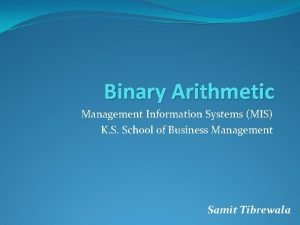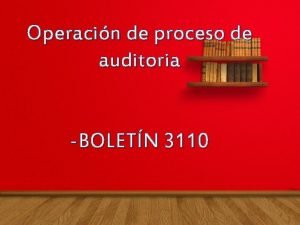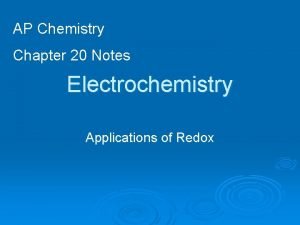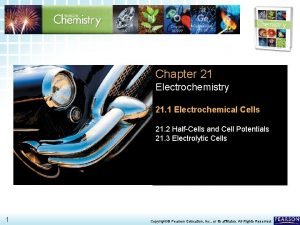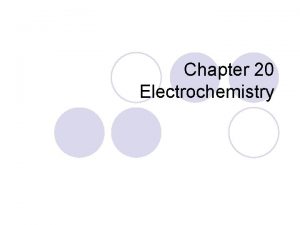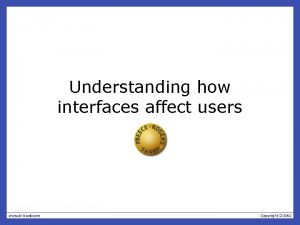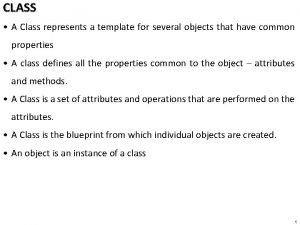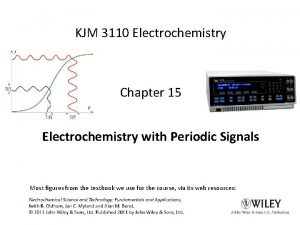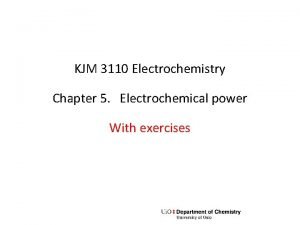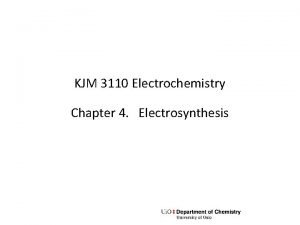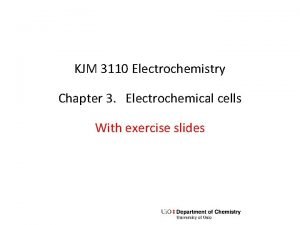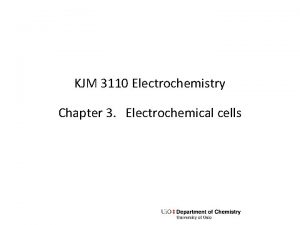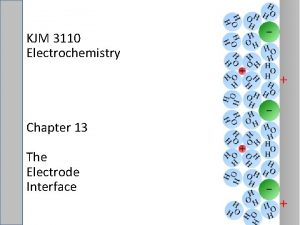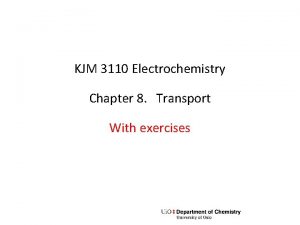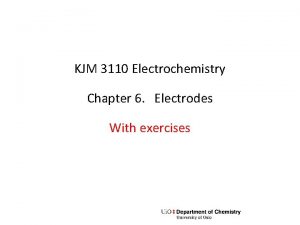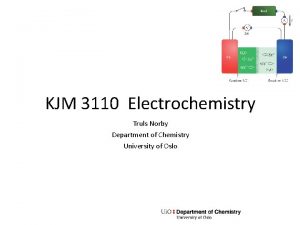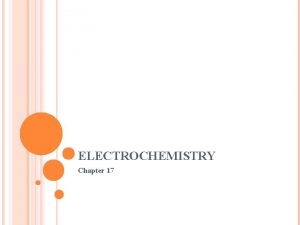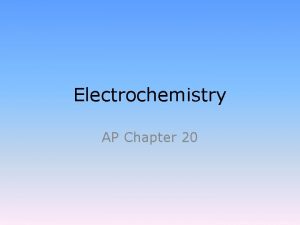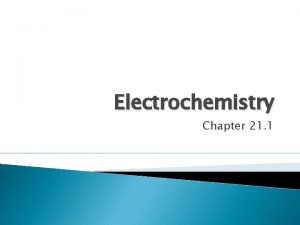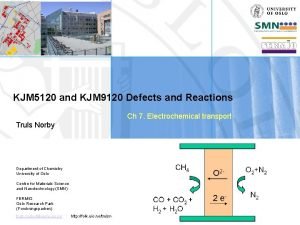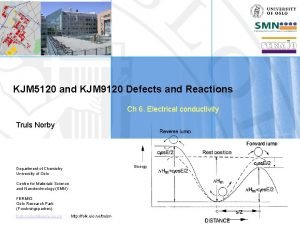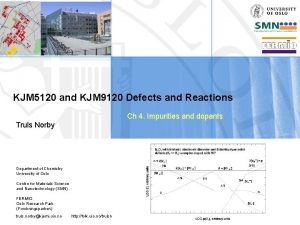KJM 3110 Electrochemistry Chapter 14 Other interfaces Most




![n-type electrode – a closer look Electroneutrality in the semiconductor bulk n + [A-] n-type electrode – a closer look Electroneutrality in the semiconductor bulk n + [A-]](https://slidetodoc.com/presentation_image_h2/d24f945ca10fc3060c044309f660031f/image-5.jpg)













- Slides: 18

KJM 3110 Electrochemistry Chapter 14 Other interfaces Most figures from the textbook we use for the course, via its web resources:

Summary Ch. 13 The electrode interface • Interface ionic conductor metal • Large capacitance • Nonfaradaic currents • Adsorption Next chapter: Other interfaces

Metallic electrodes • So far: • Working electrode is a metal (=is metallic (? )) • Always abundance of electrons • Or rather: … of lectrons and states the electrons can be in. • Now, next: • Working electrode is a semiconductor • Not necessarily any longer an abundance of electrons. Or states.

Semiconductor electrodes - overview • Semiconductor • • • Lattice Valence band = HOMO Conduction band = LUMO Band gap Fermio energy (chemical potential of electrons) Work function (to bring electrons to vacuum) • n-type semiconductor • Donor-doped n = [e-] = [D+] • Electrons e- in the conduction band • p-type semiconductor • Acceptor-doped p = [h+] = [A-] • Electron holes h+ in the valence band
![ntype electrode a closer look Electroneutrality in the semiconductor bulk n A n-type electrode – a closer look Electroneutrality in the semiconductor bulk n + [A-]](https://slidetodoc.com/presentation_image_h2/d24f945ca10fc3060c044309f660031f/image-5.jpg)
n-type electrode – a closer look Electroneutrality in the semiconductor bulk n + [A-] = p + [D+] Bulk donor doped n-type conductor n ≈ [D+] Adsorption of anions in Helmholtz layer compensated by positive space charge in the semiconductor by depletion of electrons excess of holes Band bending: Cause: Adsorption of one of the ions (same as diffuse layer in the electrolyte) Shape: Same origin (Poisson) as diffuse layer in the electrolyte - + + + + - +

Exercise • How do the bands look before contact with the electrolyte? • Based on your memory and understanding, populate the top figure with ions, electrons, and holes • Populate the bottom figure with ions, electrons, and holes • How could we force the bands flat? • What is the flat-band potential? • Try to populate the valence bands with electrons instead of holes

Photoelectrochemical (PEC) cell • n-type photoanode or p-type photocathode • Suitable bandgap • Charge separation • Photoanode

PEC water splitting, artificial photosynthesis • Low efficiencies • Photocorrosion of electrodes • Cathode traditionally a noble (platinum group) metal • Research: Non-noble metals, oxides. Enzymes • Sunlight cannot drive the reaction alone, just assist it • Research: Combine photoanode and photocathode. Combine PV and PEC. • Reduce CO 2 instead of H 2 O • Solid-state electrolyte instead of aqueous

Artificial photosynthesis Fujitsu Journal

Interface between two immiscible electrolyte solutions (ITIES) • Aqueous vs organic liquids • Use of bipotentiostat

Redox scales – SHE and ferrocene (C 5 H 5)2 Fe – for ITIES

ITIES ion and electron transfers • Proton • Electron

ITIES combined proton and electron transfers

Phospholipid…. • Zwitterion • Not curriculum

Electrokinetic phenomena • Electrolyte – insulator interface • No electrical current across • But double layers form • Scales with interface area: Porous materials, suspensions, etc. • Silica: • Terminating covalent O • H 2 O adsorb • Protolyses weakly (Silica is weakly acidic) • Glass • Ionic alkali cations compenated by ionic terminating oxygen • Reduces acidity • Adsorption of cations like Al 3+ may reverse the charge

Electroosmotic drag • Friction between the positive double layer and the solution volume • Volume rate v (m 3/s) • Field X, radius R, viscosity η • Zeta potential ζ at the slip plane • (zeta is ζ in the font set, not like in the formula in the textbook) • Similar to Helmhotz potential φH • Around -150 m. V for glass, higher for silica Electroosmotic flow is laminar, but it does not have the quadratic dependence of velocity on radius, as described on pages 161� 162, that is seen in Poiseuille (laminar) flow. This is because electro-osmotic flow is not pressure-driven; instead, it is induced by friction from the motion of the fielddriven sleeve. Thus the velocity profile is as shown in the Figure: it is uniform apart from within the narrow double-layer region.

Electroosmotic drag • Electroosmotic flow by voltage or current • Electroosmotic pressure by voltage or current • Streaming potential or current by flow or pressure • Universality • Lars Onsager reciprocal relations • Irreversible thermodynamics • Nobel prize 1968 • «Fourth law of thermodynamics»

Ch. 14 Other interfaces - Summary
 Pluronic rpe 1740
Pluronic rpe 1740 Cornell cs3110
Cornell cs3110 Ctech collections
Ctech collections What is the 8-bit unsigned binary result of 5610 − 3110?
What is the 8-bit unsigned binary result of 5610 − 3110? Boletin 3110
Boletin 3110 Ap chemistry chapter 18 electrochemistry test
Ap chemistry chapter 18 electrochemistry test Introduction of electrochemistry
Introduction of electrochemistry Ap chem electrochemistry review
Ap chem electrochemistry review Chapter 21 electrochemistry
Chapter 21 electrochemistry Difference between galvanic cell and electrolytic cell
Difference between galvanic cell and electrolytic cell Chapter 20 electrochemistry
Chapter 20 electrochemistry Expressive interface
Expressive interface Web user interface
Web user interface Uml interfaces are used to:
Uml interfaces are used to: Industrial interfaces
Industrial interfaces What is difference between abstract class and interface
What is difference between abstract class and interface Difference between abstract class and interface
Difference between abstract class and interface Expressive interfaces
Expressive interfaces Interface and dialogue design
Interface and dialogue design



